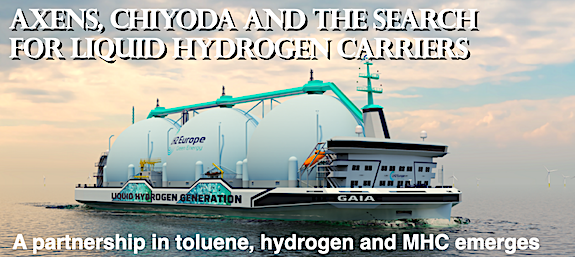Axens, Chiyoda and the search for liquid hydrogen carriers

From France and Japan comes news that Axens and Chiyoda Corporation have inked a partnership to facilitate hydrogen supply chain projects via methylcyclohexane, known widely as MCH, as a Liquid Organic Hydrogen Carrier, and promote a combination of Axens’ Toluene Hydrogenation technology and Chiyoda’s SPERA Hydrogen technology.
The hydrogen backstory
According to the International Energy Agency (IEA), the size of the hydrogen economy could be as large as 150 million tons annually in 2030. The hydrogen long distance transportation from favorable areas of production to main consumption countries remains a key challenge to be addressed from technical and economical point of view.
The liquid carrier problem
Worldwide, industry has struggled to match the promise of hydrogen technologies with the difficulties of transporting gas hydrogen around the world. Simply not enough pipeline, and the efficiencies are low. Liquefying hydrogen by lowering the temperature is a solution is you’re headed to the moon, for example, and cost is less of an object. Here on earth, the costs are high and the energy footprint becomes massive. So, thoughtful hydrogen proponents seek Liquid Organic Hydrogen Carriers that can be transported safely and effectively via, say, marine transport. MCH is an excellent candidate with a boiling point (101C) almost the same as water, and is roughly 15 percent hydrogen by mass, which is better than water (11%) though not as attractive as ammonia (18%), as liquids go.
The search for hydrogen options comes just as Rolly-Royce and easyjet have been testing hydrogen fuels in jet engines — one limitation of their approach is the use of super-cooled liquid hydrogen. More on that here.
In a nutshell, the combined technology works like this. Combine toluene and hydrogen into MHC at the front end using Axens tech, then transport, then re-divide into toluene and hydrogen at the backend using Chiyoda tech.
The partners suggest that the partnership will address issues linked to safety and difficulties of hydrogen transport and storage; and technology cost intensity by using existing infrastructure, regulations, and standards.
The bio-based options
No reason that toluene and hydrogen have to be produced exclusively from petroleum, though they usually are. At present, it’s a complex set of steps to get toluene from biomass — generally what we’ve seen demonstrated on the lab bench is producing toluene from furans using the Diels-Alder reaction; furans can be readily made from biomass, but some ethylene is generally required as well — making it technically feasible but burdensome. More on that front here.
A couple of years ago, as route to toluene via biobased isoprene and acrolein appeared here — still multi-step, but a simple enough reaction.
There would be a lot of value in discovering a catalytic process that could jump from biomass to MHC (or even toluene) in a single step. Not only the opportunities in hydrogen, but toluene is a pretty darn good little octane enhancer that comes without the blendwall issues that plague ethanol as a fuel additive.
The twin technologies
Chiyoda’s SPERA Hydrogen technology utilizes MCH as a LOHC and with Chiyoda’s proprietary dehydrogenation catalyst, it produces hydrogen and toluene from MCH with high conversion and high selectivity.
Axens’ Toluene Hydrogenation technology uses high performance homogeneous catalysis resulting in high purity MCH production from toluene and hydrogen with optimized energy efficiency. This technology is backed up by Axens unmatched experience in the field of hydrogenation through process optimization and extensive catalyst development.
The partnership rationale
The partners aver that the combination of both technologies will speed up project implementation; and simplify the technology licensing.
Reaction from the stakeholders
Patrick Sarrazin, Executive Vice President New Development & Transformation at Axens, said: “Signing this alliance will enable Chiyoda and Axens to jointly develop worldwide hydrogen markets thus accelerating and scaling up the hydrogen supply chain, contributing to a long-term CO2 emission reduction, to be on track to net-zero.”
Category: Top Stories















